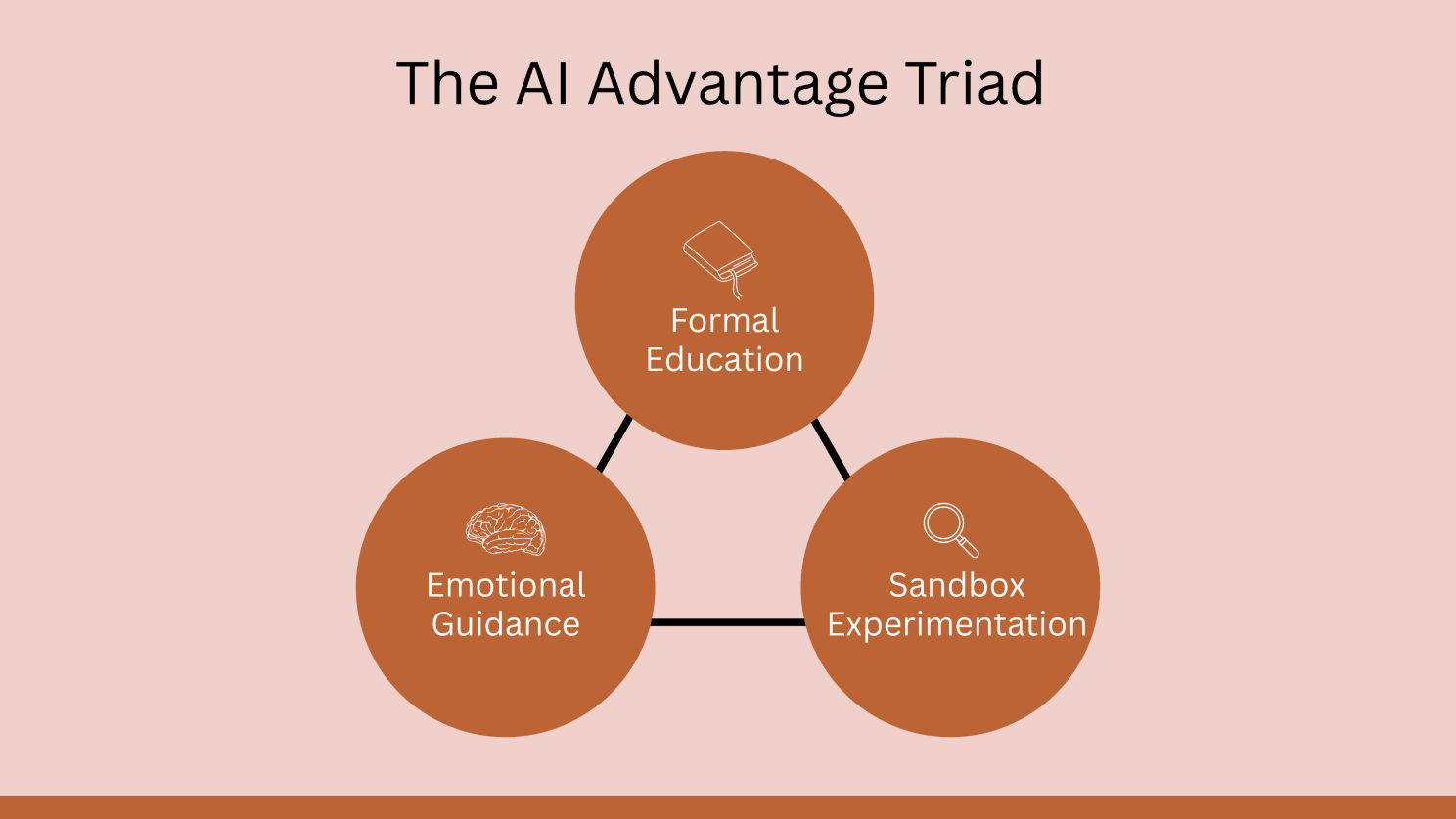11 Power Tips for Better AI Literacy in Your Team

Zinkevych from Freepik
Bad news just in from MIT on your chances of AI success. A 2025 study showed that 95% of enterprise generative-AI pilot programs fail to deliver measurable profit-and-loss (P&L) impact, and only about 5% of pilots move into production and show significant business outcomes. This study cited workflows, data readiness, organisational alignment, and governance as the culprits.
We propose another missing link likely buried under the organisational alignment category: human behavior around AI. The behavioral layers of digital transformation are the least tended area of AI progress, yet the ‘human in the loop’ is the linchpin of every single AI keystroke.
Human behaviors, either skillful or broken, may make or break your AI success. So, here are my very favorite novel approaches to AI that can minimiSe distractions and rework, opening up channels for growth and revenue in AI-savvy teams.
1. Adopt the AI Advantage Triad
Keep this framework for organisational modernisation close and refer to it with regular cadence to check your playbook. Successful AI integration requires balancing three essential elements:

Emotional Guidance: Recognition and management of the fear, resistance, and uncertainty accompanying technological change.
Formal Education: Structured learning about what AI can and cannot do, which tools serve which purposes, and the conceptual frameworks that guide effective use.
Sandbox Experimentation: Messy, imperfect, hands-on practice where team members try things that don't work, discover unexpected capabilities, and develop comfort and fluency.
Executive Action Tip: Audit your current AI plan against these three elements. You may find that your playbook is 95% formal education. Rebalance accordingly.
2. Conduct an AI Hot Wash
A Forrester study shows that over-reliance on AI causes cognitive laziness. Therefore, it is critical to make sure that the project as a whole was managed better with AI than without it. After any complex AI project, invest fifteen minutes in a ‘hot wash,’ a rapid review to determine whether the AI saved time or created additional labor.
Executive Action Tip: Create a simple rotating three-question review at project end. Select three from this list and rotate them:
- Did using the AI reduce the overall quality of the final work?
- Did the AI save us time overall, even accounting for edits and rework?
- Did the AI introduce any new ideas or perspectives we wouldn't have considered?
- Did the AI help us discover any inefficiencies in our usual process?
- Did the AI save time for future tasks by learning from this one?
This discipline transforms each project into organisational learning and betterment of the next AI time investment.
Related: Have We Started Outsourcing Our Minds to AI?
3. Mitigate AI Distrust Through Revealing Flaws
AI systems hallucinate, fabricate sources, and confidently present incorrect information. When team members discover this after depending on AI outputs, they may abandon the technology as trust has been broken.
Executive Action Tip: In AI training sessions, demonstrate a live hallucination. Ask an AI tool to cite sources for a claim, then verify that those sources don't exist. This controlled exposure builds healthy skepticism and teaches your team the critical habit of verification.
4. Appoint AI Sherpas
Identify a few team members to become your AI Sherpas. These dedicated guides are tasked to develop deep expertise in AI applications relevant to your work. These aren't IT specialists; they're trusted colleagues who become relatable advisors having been given more time with AI than others.
Executive Action Tip: Select your Sherpas based on curiosity and credibility, not purely technical background. Invest in their development through seminars, online courses, and dedicated learning time; up to 10 hours weekly. Their role is to demystify AI for colleagues and serve as first-line support.
5. Create Capacity for AI Relationship Building
51% of workers say that learning AI feels like taking on a second job. To help your team develop a genuine relationship with AI tools, you must create dedicated space and time. Relationship building requires time, not leftover minutes crammed between other priorities.
Executive Action Tip: Cancel two hours per week of your team's current activities and designate that time specifically for ‘AI relationship building’. Give them room to explore and become comfortable without pressure for immediate deliverables.
6. Minimise AI Slop and Rework
Leaders accepting good-enough output as a result of AI-driven quality degradation is called Satisficing. The often mediocre output of AI-generated work then either lowers client-facing quality (a net loss to the business) or demands extensive revision. When teams use AI prematurely on complex tasks, they often create more work than they save.
Executive Action Tip: Exercise restraint with AI on your most intricate projects until both the technology and your team's proficiency mature. By waiting strategically, you reduce unnecessary rework and maintain efficiency from the start.
7. Allow Best Practices to Scale
Effective AI adoption requires ongoing change management, not one-and-done training. Once a month, establish an organisation-wide hour with no scheduled meetings for an ‘AI Idea Exchange’. Everyone shares their most effective AI applications and observes what colleagues are discovering.
Executive Action Tip: Encourage team members to come prepared with one AI insight or challenge. Include competitive intelligence or permission to share sticking points. This transforms isolated experimentation into organisational capability.
8. Separate Education from Experimentation
As the AI Advantage Triad shows us, simply teaching your team about AI is not enough; they need dedicated, low-risk time to play with it directly.
Executive Action Tip: Help your team distinguish between learning the rules of AI (like studying the rules of tennis) and actual 'court time'. Separate theoretical learning sessions from hands-on experimentation periods. Both matter, but they serve different purposes.
Related: To Use AI Tools Smartly, Think Like A Strategist
9. Amplify Presence with AI Note-Taking
With constant virtual meetings, our cognitive capacity for recall is overwhelmed. By deploying an AI note-taker in every meeting, you offload the mental burden of capturing details and focus your full attention on the strategic conversation.
Executive Action Tip: Implement a tool like Sybill to automatically generate detailed summaries and transcripts of virtual meetings. Comprehensive notes improve clarity, reduce misunderstandings, and make follow-ups more efficient. (Bonus, they also reduce FOMO and make people more likely to opt out of unnecessary meetings as the information can be sourced later.)
10. Use In-Room AI Transcripts to Enrich In-Person Sessions
For in-person meetings, events, or off-sites, valuable insights emerge that are easily forgotten. A dedicated AI voice recorder ensures you capture a precise, in-room transcript of everything discussed.
Executive Action Tip: Use a device like the HiDoc P1 AI voice recorder to capture accurate transcripts of all in-person discussions. This ensures no valuable comment or strategic insight disappears.
11. Incentivize the AI Challenge
AI represents an exciting frontier, and engaging your team's sense of adventure makes the learning curve more enjoyable. When you add the carrot factor, you unlock creativity and voluntary engagement.
Executive Action Tip: To help employees push through the cognitive bias against AI, establish a monthly competition with meaningful rewards (such as a cash prize or an extra day off) for the most innovative application of AI to real work challenges.
Turning Literacy Into Leverage
AI success will not belong to the fastest adopters; it will belong to the most literate ones. The differentiator in this next phase of digital evolution isn’t just access to tools, but the quality of human engagement around them.
Leaders who treat AI literacy as a core competency (not a side project) will create cultures where technology amplifies judgment instead of replacing it. They’ll see fewer false starts, less rework, and more measurable ROI, not because their algorithms are smarter, but because their people are.
As you look ahead, remember: every competitive advantage begins with behavior. Equip your teams to think critically, experiment wisely, and engage deeply. That’s where AI stops being a headline and starts becoming a lever for real performance.
This was also published on Juliet Funt's LinkedIn.
Invest in Your Leadership Journey
Leadership





